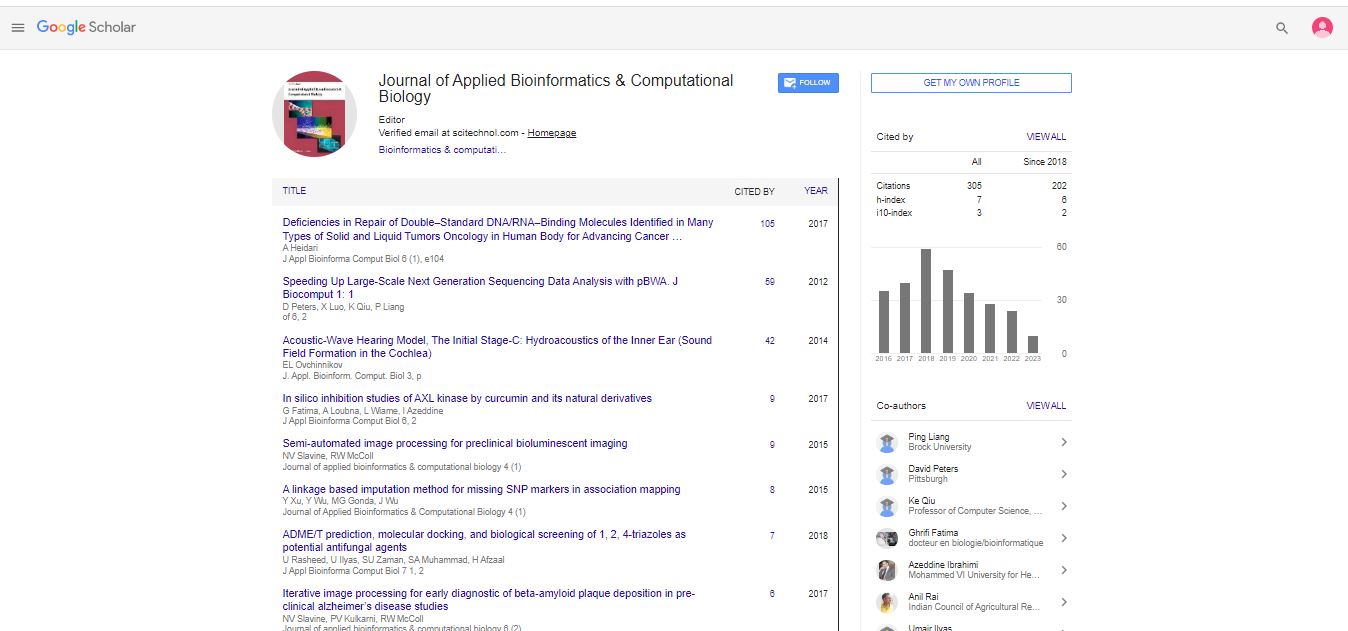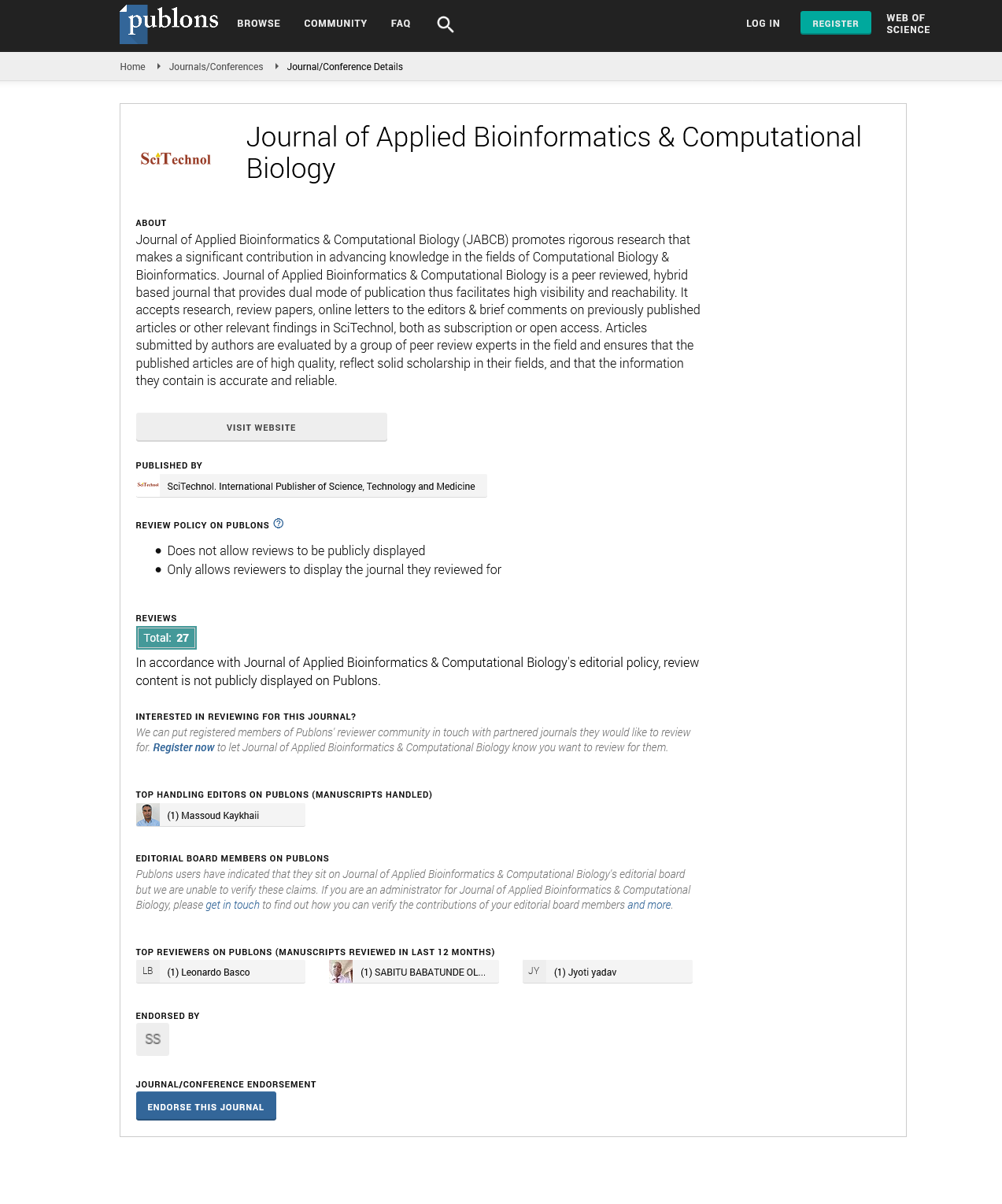Perspective, Vol: 14 Issue: 1
Molecular Structures with the Comprehensive Examination of Homology Modeling in Protein Science
Alexander Plonski*
Department of Zoology, University of Copenhagen, Copenhagen, Denmark
*Corresponding Author: David Karrow,
Department of Zoology, University of Copenhagen, Copenhagen, Denmark
E-mail: plonskia45@gmail.com
Received date: 20 February, 2024, Manuscript No. JABCB-24-127920;
Editor assigned date: 22 February, 2024, PreQC No. JABCB-24-127920 (PQ);
Reviewed date: 04 March, 2024, QC No. JABCB-24-127920;
Revised date: 22 April, 2025, Manuscript No. JABCB-24-127920 (R);
Published date: 29 April, 2025, DOI: 10.4172/2329-9533.1000292
Citation: Plonski A (2025) Molecular Structures with the Comprehensive Examination of Homology Modeling in Protein Science. J Appl Bioinforma Comput Biol 14:1..
Introduction
Homology modeling, also known as comparative modeling, stands as a cornerstone in structural biology, enabling researchers to predict the three-dimensional structures of proteins based on the known structures of related proteins. This predictive approach has revolutionized our understanding of molecular function, enabling insights into drug design, protein-protein interactions, and evolutionary relationships. In this comprehensive exploration, we delve into the principles, methods, applications, and future directions of homology modeling.
Description
Fundamentals of homology modeling
Homology modeling relies on the principle of evolutionary conservation, where proteins with similar sequences are presumed to share similar structures and functions. Central to this technique is the sequence alignment of the target protein with one or more template structures of known three-dimensional geometry. Alignment algorithms, such as BLAST and PSI-BLAST, facilitate the identification of evolutionary relationships and guide the construction of accurate models.
Methodology: The process of homology modeling involves several sequential steps, including template selection, sequence alignment, model building, refinement, and validation. Template selection requires careful consideration of factors such as sequence identity, coverage, and structural quality. State-of-the-art software tools like MODELLER, SWISS-MODEL, and Rosetta accelerate the modeling process by automating many of these steps while allowing for user intervention to optimize results.
Challenges and solutions: Despite its utility, homology modeling encounters challenges, particularly in cases of low sequence identity or the absence of closely related templates. In such instances, advanced modeling strategies like loop modeling, fragment assembly, and de novo modeling are employed to overcome limitations. Moreover, refinement techniques utilizing molecular dynamics simulations, energy minimization, and side-chain optimization enhance the accuracy and reliability of generated models.
Applications: The applications of homology modeling are multifaceted and span various fields of biological research and drug discovery. In structural biology, homology models serve as valuable tools for elucidating protein function, dynamics, and interactions. Additionally, these models facilitate rational drug design by providing insights into ligand binding sites and mode of action, accelerating the drug development process. Furthermore, homology modeling plays a pivotal role in understanding the molecular basis of diseases, guiding the design of targeted therapies tailored to individual patient profiles.
Emerging trends and future directions: Advancements in computational power, algorithm development, and structural databases continue to propel the field of homology modeling forward. Integration of machine learning algorithms, such as neural networks and deep learning, holds promise for enhancing the accuracy and efficiency of modeling procedures. Moreover, the advent of cryo- Electron Microscopy (cryo-EM) provides complementary structural information, enabling the refinement of homology models at higher resolutions. Looking ahead, interdisciplinary collaborations and technological innovations are poised to expand the horizons of homology modeling, driving transformative discoveries in structural biology and beyond.
Conclusion
Homology modeling stands as a powerful tool in the arsenal of structural biologists, offering a cost-effective and efficient means of predicting protein structures and elucidating molecular mechanisms. As computational methods continue to evolve and experimental techniques advance, the synergy between homology modeling and experimental validation promises to unravel the complexities of biological systems with unprecedented clarity. By harnessing the predictive power of homology modeling, researchers can unlock new frontiers in drug discovery, personalized medicine, and our understanding of life at the molecular level.
 Spanish
Spanish  Chinese
Chinese  Russian
Russian  German
German  French
French  Japanese
Japanese  Portuguese
Portuguese  Hindi
Hindi 
